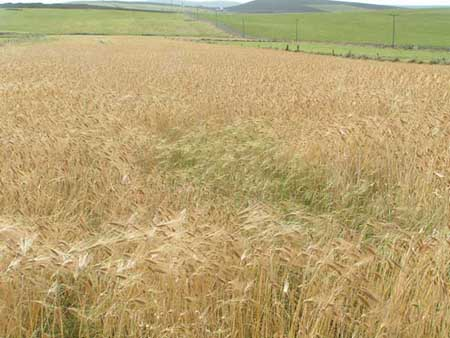Biodiversity And Crop Plants
Published on 27 May 2009 in Ecosystems and biodiversity
Introduction
We are now living in a world of accelerating change affecting climate, crop pathogens and demands for improvement in the quality and nutritional value of our food. Adapting crops rapidly to new situations becomes an increasing challenge requiring the intelligent use of the latest advances in our understanding of plant genetics. Most crops have a diverse genetic base that breeders draw on to identify new sources of genes for trait improvement. This diverse base comes in different forms, ranging from traditional varieties and landraces adapted to cultivation methods without modern fertilisers and equipment, to wild relatives collected from the centres of origin of the crop species. These wild relatives contain, for example, genes useful for combating new pathogens or challenging growing environments. To maintain a productive agriculture we need to be drawing on this wealth of genetic resources, and using efficient mechanisms to incorporate the traits they bring into modern varieties to meet the challenges ahead.
Key Points
- The harnessing of biodiversity represents a key approach in the adaptation of crops to ever-changing challenges of food production.
- A tremendous wealth of adaptation can be found in landraces and traditional varieties, and in the wild relatives of the crops which have already found solutions to some of the problems facing agriculture.
- In crop improvement programmes our capacity to identify the most appropriate genes from these biodiverse collections is accelerating, but the best science is required to understand the genetics of important traits and to transfer them efficiently to high yielding varieties.
- Conservation of such biodiverse collections and their ethical use needs to meet the international obligations that governments made through agreements such as the Convention on Biological Diversity and the International Treaty on Plant Genetic Resources.
Research Undertaken
Research undertaken on crop biodiversity covers a wide range of topics. The major revolution has come from technological advances which allow us to determine, rapidly and cheaply, the DNA of entire genomes. This opens up opportunities for identifying the best genes to improve the trait of interest.
Internationally significant potato germplasm
Scotland looks after one internationally recognised crop and crop wild relatives genebank, the Commonwealth Potato Collection (CPC). The collection comprises around 1500 accessions of about 80 wild and cultivated potato species. Each accession traces back to a handful of berries or tubers from potato plants in South or Central America, gathered from the wild or obtained from a grower at a market. This collection is maintained to international standards and is Scotland’s contribution to the multilateral system regulated by the International Treaty on Plant Genetic Resources for Food and Agriculture. The importance of the collection to the potato industry is hard to over-emphasise. Genes from the plants held within the collection can be found in most varieties which are grown today. This includes the gene known as H1 which provides resistance to a major potato pest - Potato Cyst Nematode. Furthermore, new potato varieties such as Mayan Gold, which has unique flavour and texture have been developed from the CPC which provides a major repository of the variation required by breeders to deal with the challenges of sustainable agriculture production in the future. Next generation crops must deal not only with new pests and disease but also with reduced access to declining supplies of water and fertilisers.

Image: Diversity in floral type in tuber-bearing wild relatives of the potato.
Scotland’s barley heritage
In the Western Isles and in Orkney and Shetland crofters still maintain remnants of the once widespread bere barley. This spring 6-row type is unique in the UK and has been replaced by other types in intensive farming, yet is well adapted for the extreme conditions in which it is grown. As well as having particular properties for new food uses, it copes with low input systems and a range of soil types, indicating a potential role in providing the genetics for lower input systems of the future. Molecular work has indicated that the populations across its range are genetically distinct, implying local adaptation and a low impact of the historical movement of seed.

Image: Bere barley on the machair.
Fruit biodiversity
Fruit adds diversity to diets and is a major source of the vitamins and antioxidants necessary for healthy human populations. Research includes the study of nutritionally related components in diverse fruit types, and seeks the variation in life cycle timing (for example, bud break), required to adapt fruit crops for future and current climates.
Policy Implications
Crop-related biodiversity links with government priorities in several ways. International agreements such as the Convention on Biological Diversity and the International Treaty come with commitments to look after native and crop-related ex situ biodiversity. Exploitation of such biodiversity should now have regard to stemming any further loss of native biodiversity and to returning benefit to countries that have donated the plant materials which comprise the biodiversity collections Scotland’s research institutes are fully aware of the requirements of these agreements and act in collaboration with partners across the UK to meet these obligations.
Policy also requires that we focus on maintaining sustainable food production and rural communities, and on developing crops and cropping practices which reduce harmful effects on the environment. The exploration and utilisation of crop biodiversity is helping us to meet all of these aims.
Adaptation to current and future climate change is an essential part of preparing for a sustainable future. We need to prioritise the traits for improvement and identify the genes and combinations of genes which underpin these traits. Only then can we use knowledge-based crop improvement to its full potential in managing the effects of climate change.
Author
Dr Gavin Ramsay, SCRI Champion for Biodiversity Gavin.Ramsay@scri.ac.uk







